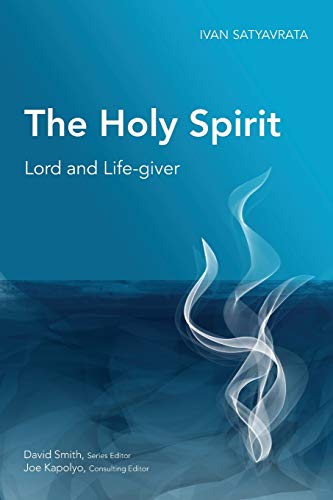The Holy Spirit: Lord and Giver of Life
Written by Ivan Satyavrata Reviewed By Stephen JenksIvan Satyavrata’s The Holy Spirit: Lord and Giver of Life forms part of a series “Christian Doctrine in Global Perspective,” edited by David Smith and John Stott. In the series introduction, the editors note and lament that in spite of the geographical shift of Christianity away from the West and toward the East and South, the preponderance of theological writing is still of Western provenance. What is needed is a surge of theological reflection from within non-western sectors of Christianity not only for their own enrichment but for the nourishment of Western Christianity as well. Accordingly, the series attempts to allow “distinct voices [to] bring fresh insight to the traditional theological categories” (back flap) in hopes of bringing an “injection of non-Western Christian vitality” to the many decaying Western churches (p. 10). Though not the first book in the series, there is certainly no better place to start such an ambitious project than with the doctrine of the Holy Spirit.
Satyavrata begins by orienting his treatment to the contemporary situation in the world and the church. In chapter one he discusses both the advantages and challenges of the increased openness to the “spiritual” in the world today. In particular, he notes that this resurgence of the spiritual compels Christian theology to articulate carefully the distinctly Christian understanding of the Spirit. In a second conversation-orienting chapter, the author surveys the broad sweep of Christian history to demonstrate both the vast and rich theological resources the church can lay claim to but also to show that there is nothing new about the differences of doctrinal opinion that characterize much of Christian Holy Spirit talk today. In this second chapter, Satyavrata displays the ability to survey material concisely and readably.
In chapter three the author puts this skill to work once again in a brief but remarkably thorough treatment of the role of the Holy Spirit in the OT. He rightly observes the oft-overlooked fact that the OT presentation of a creative, enabling, prophetic, and messianic Spirit is necessary background if one hopes to construe the NT witness to the Spirit rightly.
Turning to more specifically theological concerns, in chapters four and five Satyavrata discusses the personhood and deity of the Holy Spirit as well as the relation of the Spirit to the other members of the Godhead. If there is a weakness here, it is the slender amount of space accorded to such major issues. In discussing the personhood of the Spirit, for example, he addresses only briefly the way the biblical idea of the personhood of the Holy Spirit contradicts notions of spirit in other religions and in the culture more broadly. After raising the issue of the challenges of increased spirit-talk in the introduction, one might have expected a more detailed treatment of this issue.
Satyavrata dedicates a further chapter to the relationship between the Spirit and the word. While he rightly notes the Spirit’s involvement at every point in the process from revelation to inspiration to canonization to illumination, the chapter reads more like a classic bibliology than a Pneumatology.
Two more chapters deal with other standard topics in Pneumatology: the work of the Spirit in salvation and in the church. While Satyavrata is well aware of the thorny issues involved in these areas, he attempts to steer clear of the debates regarding experience of the Spirit subsequent to salvation and sign gifts, choosing instead to emphasize the considerable common ground that the various camps share. This is certainly in keeping with the survey-nature of the text but may leave some readers dissatisfied.
This effort at an irenic tone, though appreciated by this reviewer at one level, is confusing somewhat with regard to the book’s intended audience. For good or for ill, many readers of works on Pneumatology read them for their insights on just these sorts of issues. Unfortunately, not only does he not present the various positions in any detail, he does not even make his own position clear. Further, it is at places such as this in the book that the lack of a clearly “global” perspective is most disappointing. The categories and boundaries of these arguments have been so firmly drawn in the English-speaking debate that forward progress is doubtful. This reader hoped for a different perspective through the eyes of a different culture.
Herein lies my main critique of the book. Clear evidence of a unique, global perspective seems in short supply. The organization of the material is fairly standard, as are the topics discussed. Apart from the fact that many of the illustrations that the author uses are drawn from his personal experiences as a member of another culture, there is not much that sets this book apart from other introductory level texts on the Holy Spirit.
Satyavrata writes very clearly and his use of personal examples at the beginning of many chapters to set up discussions of the various topics makes the text readable and engaging. As an introduction to issues and questions in Pneumatology, the work surveys no new ground but provides a readable non-technical treatment accessible to the layperson. As a contribution to theology in global perspective, however, it falls short of its goal.
Stephen Jenks
Stephen Jenks
Union Christian Church
Tegucigalpa, Honduras
Other Articles in this Issue
I didn’t come from an Evangelical home, and though he never told me outright, I’m sure my father never wanted me to become a pastor...
Does Baptism Replace Circumcision? An Examination of the Relationship between Circumcision and Baptism in Colossians 2:11–12
by Martin SalterReformed paedobaptists frequently cite Col 2:11–12 as evidence that baptism replaces circumcision as the covenant sign signifying the same realities...
New Commentaries on Colossians: Survey of Approaches, Analysis of Trends, and the State of Research
by Nijay GuptaNew Testament scholarship in its present state is experiencing a time of abundance, especially with respect to biblical commentaries of every shape, length, level of depth, theological persuasion, intended audience, and hermeneutical angle...
It might seem odd to write an editorial for a theological journal on the topic of not doing theology and how important that can be; and, indeed, perhaps it is contrarian even by my own exacting standards...
Most readers of Themelios will be aware that the word “perfectionism” is commonly attached in theological circles to one subset of the Wesleyan tradition...







